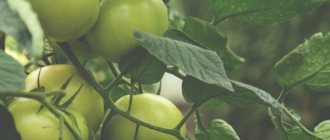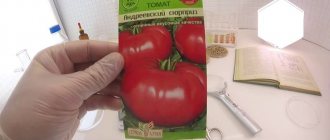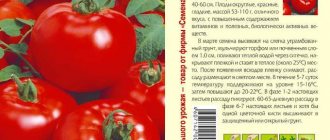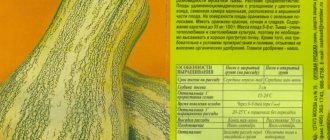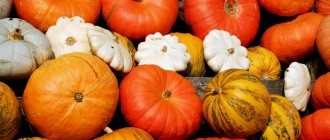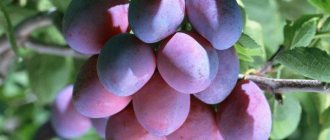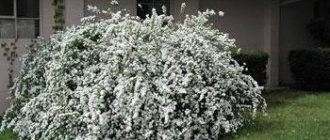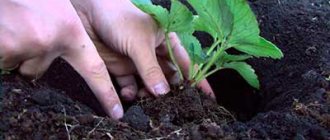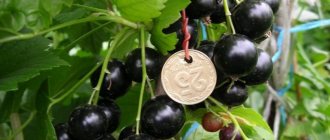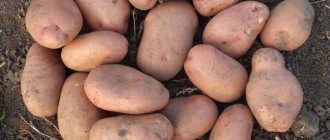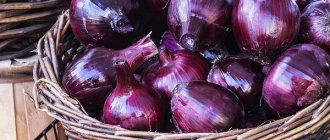Vegetable growing » Pumpkin
0
655
Article rating
Kira Stoletova
The largest vegetable in the world, pumpkin, is known for its beneficial properties and taste. It is grown in any area. One of the popular varieties is the gray Volzhskaya pumpkin, which is distinguished by its long shelf life and resistance to diseases. It does not require special care and does not create difficulties for the gardener.
Characteristics of Volzhskaya gray pumpkin variety
Description and characteristics of the “Grey Volga pumpkin”
“Volzhskaya gray 92” is a mid-season and large-fruited variety, bred in 1940. Regions recommended for cultivation are the North Caucasus, the Lower Volga region, and some areas of the Urals.
The plant is of medium size. There is a thick central shoot from which thinner side shoots branch. The foliage is moderate. Leaves are prone to drying out. With good watering, the foliage is raised and covers the pumpkins, protecting them from the scorching sun.
The flowers of this variety are medium-sized, pale yellow, slightly pubescent on the outside.
Description of fruits
It is easy to recognize the “Volga gray” pumpkin by the gray color of the pumpkins. Even in a state of rich ripeness, the rind does not turn yellow.
Description of fruits:
- Form. The fruits of “Volga Gray” are round, slightly flattened at the top and bottom.
- Crust. Smooth, dense, segmented. Without picture.
- Color. The ripe fruit has a light gray rind. Sometimes with a greenish tint.
- Pulp. The inside of the fruit is cream or yellow; when fully ripe, the flesh turns orange. Density and sweetness are medium. The thickness of the pulp layer is 4-5 cm.
- Seeds. Semi-oval, pronounced pumpkin taste. They are consumed raw and fried.
The average weight of pumpkins is 10 kg. Some specimens reach a weight of 20 kg. 2-3 fruits grow on one bush.
Main characteristics
"Volga gray" pumpkin is sun-loving, but its leaves are afraid of sunburn. It can grow in shaded areas if it receives stable, indirect sunlight.
Main characteristics of the “Volga gray” pumpkin:
| Characteristics/parameters | Description/meaning |
| Ripening time | 3.5-4 months (mid-season) |
| Cold resistance | Withstands temperatures down to +10 °C |
| Drought resistance | High |
| Pest resistance | Average |
| Productivity | 15 kg per 1 sq. m |
| Purpose | Universal |
| Transportability | good |
| Keeping quality | Excellent |
Description of the variety
The fruits of Volga gray tolerate transportation well. Pumpkins are mainly grown for sale. The keeping quality of the product is high. Pumpkin retains its presentation for a long time even without special conditions. The culture is characterized as drought-resistant. In less suitable conditions, the fruits lose their taste, but the yield remains the same.
Minimal watering and high ambient temperatures are not critical for pumpkin: proper cultivation and care are determined by the composition of the soil and the climatic characteristics of the region where the crop is ripening.
Distinctive features
Pumpkin is grown both by seedlings and by direct sowing in the ground. Medium-sized bush: lashes spread from the main shoot to the sides. The more sunlight a plant gets, the greener the leaves become. The pubescence of the leaf plate is average. The foliage is divided into visible segments. Closer to harvest, it loses moisture and dries out.
Long lashes have an average thickness. The color of the side shoots is rich green. Closer to the stalk the color becomes darker with stripes. When bushes grow, they often intertwine with each other. With timely watering, the leaves rise above the fruits - this gives the vegetables additional protection from the scorching rays of the sun.
Fruit characteristics
The variety has an unusual color. The gray dense peel never turns yellow. Inside is soft and rich in taste juicy pulp. Pumpkin has high taste qualities: if the fruit has time to ripen, it does not need to rest - the pulp is ready to eat. The use of the vegetable is universal. It is consumed baked, boiled or raw.
The fruits are characterized by the following features:
- the peel is thick, elastic, without spots and ribs;
- round shape, slightly flattened on both sides;
- the division into segments is partially expressed - the larger the vegetable, the more segments;
- the thickness of the pulp is 5 cm or more, the color is yellow, and closer to harvest it becomes orange;
- The seeds are round in shape, tasty and healthy.
There is no pattern on the fruits. If you regularly water and fertilize the soil, the color of the skin will be more saturated.
Productivity
Large-fruited and mid-season crops are grown throughout Russia. From the moment of emergence of seedlings until the ripening of full-fledged fruits, 110-120 days pass. Pumpkin has good yield: the average weight of one vegetable is 9-10 kg; with good care, larger specimens grow.
Advantages and disadvantages of the variety
Advantages of “Volga gray” pumpkin:
- Able to tolerate long droughts, provided that the ovaries have already formed.
- Consistently high yield.
- Large fruits.
- High taste qualities.
- The pulp of the fruit contains a lot of beta-carotene, potassium and iron.
- Thanks to the dense crust, it has good shelf life. During storage, the fruits do not lose color and taste, and do not rot.
Flaws:
- Increased demands on fertilizing. To get many large fruits, the crop needs regular feeding with mineral and organic fertilizers.
- Low cold resistance. The variety is more suitable for the southern regions.
Reviews
Experienced gardeners rate the gray variety positively. The main advantage of the vegetable is its taste. With minimal costs, you can stock up on crops for six months. Pumpkin is well stored and easily transported over long distances.
Gardeners advise growing the variety in regions with a temperate climate. A large amount of sunlight and moderately humidified air will allow you to get a good harvest. The pumpkin variety has few disadvantages, which is why it is so popular in Russia.
Features of planting and growing
This variety of pumpkin is grown by direct sowing of seeds in the ground or seedlings. The future harvest is influenced by many factors - the quality of seeds and seedlings, planting dates, soil, site characteristics and much more.
About deadlines
The timing of planting pumpkins depends on two factors:
- The growing region, its climate and current weather conditions.
- Growing methods - planting times for seeds and seedlings are different.
In the southern regions, seeds are sown in open ground in mid-May, in cooler regions - in early summer.
When choosing the timing of landing, they are guided by the weather. Pumpkin is planted when the soil warms up to +14-+17 °C. If you plant seeds or seedlings in colder soil, they will begin to rot.
The timing of sowing seeds for seedlings is calculated taking into account the rule - seedlings transplanted into the ground should be about 1 month old.
Choosing a landing site
Site requirements:
- Well lit place. Slight shading possible.
- Deep groundwater. You cannot plant pumpkins in lowlands - the fruits will not be sweet and watery.
- The soils are loamy and sandy loam, loose and well fertilized with organic matter.
- Neutral soil acidity level.
- No tall plants should grow nearby.
- The best soils are loams and sandy loams. Clay soils are not suitable for growing pumpkins - the fruits develop thin and hard pulp.
- Optimal predecessors are onions, green manure, cabbage, legumes, radishes. You cannot plant pumpkin after potatoes, sunflowers, zucchini, squash, cucumbers, melons and watermelons.
The optimal temperature for the growth and development of Volga gray pumpkin is +25 °C.
Site preparation
Soil preparation begins in autumn:
- The area is dug up, adding compost or rotted manure. The norm of manure is 1 bucket per 1 sq. m.
- Additionally, mineral fertilizers are applied - 50 g of potassium salt and 80 g of phosphorus per 1 sq. m. m.
- In the spring, before planting, the area is dug up again.
Many gardeners plant pumpkins directly on compost heaps, then fertilizing will not be needed throughout the entire growing season.
Seed preparation
Pumpkin seeds are prepared for planting as follows:
- Soak in a weak solution of potassium permanganate - 60 minutes. The procedure is aimed at disinfecting the seeds.
- Wrap in damp cloth to hatch. From time to time, moisten the fabric with water - for example, using a spray bottle. Sprouts appear after a few days.
Gardeners have another method of preparing seeds:
- Keep the seeds in the oven at a temperature of +40 °C.
- Keep for 12 hours in gauze soaked in ash solution.
Sowing seeds
Planting pumpkin seeds in open ground:
- Prepare the wells in advance. The distance between adjacent holes is 60-80 cm, between rows - 1.5-2 m. The pumpkin needs space, so you should not reduce the gaps.
- Pour 1-2 liters of warm water into the wells, heated to +50 °C.
- Wait for the water to be absorbed and bury the seeds - pointy ends down. Place 2-3 seeds in one hole. When shoots appear, leave the strongest sprout and pinch off the rest.
- Sprinkle the seeds with soil - a layer of 6-7 cm. If the soils are heavy, 3-4 cm is enough. Mulch the crops with peat or compost.
- Cover crops with film if there is a risk of frost. Thanks to the greenhouse effect, seedlings will appear faster.
Seedling care
It can take up to 10 days for seeds to germinate. Another 30 days will be needed to grow seedlings. Count 40 days from the intended planting date, and soak the seeds on this day.
Procedure for growing pumpkin seedlings:
- Prepare planting containers. The best option is peat cups, since pumpkin does not like transplants, and this “container” can be buried in the ground along with the roots of the seedlings.
- Plant the germinated seeds in peat containers. If they are not available, use glasses filled with a mixture of turf soil, humus, peat and mullein (1: 3: 5: 1). Planting depth is 4-6 cm. Before sowing, do not forget to water the soil well.
- Cover the crops with film. Ventilate your crops regularly. The optimal daytime temperature is +25 °C, night temperature is +15-+18 °C.
- When shoots appear, remove the film. To prevent the seedlings from stretching, place them in a well-lit place. First, reduce the daily temperature to +15-+18 °C, and after 5 days raise it again.
- Water the seedlings as the soil dries out.
- A week after emergence, feed the seedlings - 15 g of nitrophoska per 10 liters of water, or mullein (1:10 solution).
- When the seedlings reach 15-20 cm, you can plant them in open ground.
Transplanting seedlings
As soon as the pumpkin seedlings reach condition and favorable conditions are created, they are transplanted into open ground:
Procedure for transplanting seedlings:
- In a pre-prepared area, dig holes according to the same pattern as when planting seeds - 60-80x150-200 cm.
- If the seedlings are grown in peat pots, destroy the dense outer walls. If the seedlings grew in a substrate - in glasses or containers, water them in advance to make it easier to transfer them into the hole.
- Plant seedlings in cloudy weather or in the evening. Try to move it along with the soil so as not to damage the roots.
- Water the seedlings generously and shade them for the first time.
- Mulch the soil and create a border around each seedling to prevent water from spilling out when watering.
For Siberia
Growing crops in this area requires special skill. The presented varieties are characterized by a high degree of resistance and will be able to withstand the cold Siberian climate well. Quickly ripening pumpkins are held in high esteem.
Adagio
What's significant:
- Form. Very neat, round, smooth, with uniform segmentation.
- Weight. Not very large, only 3 kg.
- Color. The skin has a uniform orange color. The contents inside are a slightly lighter shade.
- Pulp. The fruits are pleasant to the taste, sweet, full of juice, rich in vitamins.
- Resistance to bad weather conditions. High.
- Growing season. You will have to wait 100 days from emergence to harvest.
Freckle
What's special about this variety:
- Form. Pumpkins are round, smooth, slightly flattened on top and bottom.
- Weight. Quite small, rarely exceeds 3 kg.
- Color. The skin is gray-green, with a fine mesh pattern. In the cross section you can see a rich orange tint
- Pulp. It tastes like a pear, juicy and sweet.
- Resistance to bad weather conditions. High.
- Growing season. Freckles are harvested within 90 days after planting.
Table of the main characteristics of popular pumpkin varieties:
| Name | Peculiarity | Growing season, months | Fruit weight, kg | Fruit shape |
| Azure | Large-fruited | 105-115 | 5-8 | Round oblate |
| Flashlight | 95-110 | 4-7 | Round | |
| Russian porridge | 110-120 | 5-8 | Round | |
| Crocus | 105-115 | 4-7 | Round | |
| Baby | With small fruits | 90-100 | 2-4 | Round oblate |
| Sweetie | 110-115 | 1,5-2,5 | Round oblate | |
| Chit | 110-115 | 2-4 | Round | |
| Russian | 100-110 | 1,5-2,5 | Round elongated to the top | |
| Olga | With a hard crust | 110-120 | 4-7 | Oval |
| Bun | 90-100 | 1-2 | Round | |
| Lady's nail | 95-105 | 3-5 | Oval | |
| Honey dessert | Sweet | 100-110 | 5-10 | Round oblate |
| Winter sweet | 130-140 | 8-12 | Round oblate | |
| Paris gold | 110-115 | 10-14 | Round oblate | |
| Volga gray | 115-125 | 8-10 | Round | |
| Zorka | For cereals | 110-115 | 5-8 | Round |
| Granddaughter | 105-110 | 2-3 | Round oblate | |
| Smile | 80-90 | 0,5-1,0 | Round | |
| Pear | Decorative | 90-95 | 0,1-0,3 | Like a pear |
| Crown | 110-120 | 0,1-0,3 | Round with “rays” | |
| Warty | 95-100 | 0,1-0,3 | Round with growths | |
| Little Red Riding Hood | 95-100 | 0,2-4 | Light below, red above | |
| hundred pound | Stern | 110-120 | 15-20 | Round |
| Basal | 110-115 | 8-10 | Round | |
| Rosy plump F1 | Hybrids | 100-110 | 6-8 | Round |
| Matilda F1 | 110-115 | 2-3 | Elongated on top, rounded on bottom | |
| Hazelnut F1 | 90-100 | 1-2 | Round | |
| Spanish guitar | Muscat | 100-110 | 6-8 | Elongated on top, rounded on bottom |
| Muscat de Provence | 110-115 | 3-4 | Round oblate | |
| Walnut | 100-105 | 1-2 | Elongated on top, rounded on bottom | |
| Marina from Chioggia | With an unusual taste | 120-130 | 8-12 | Round oblate |
| Pastille champagne | 90-95 | 2,5-3,5 | Oval | |
| Amazon | Precocious | 90-95 | 0,5-1 | Round |
| Medical | 90-95 | 3-6 | Round oblate | |
| Gribovskaya bush 189 | 80-90 | 5-7 | Oval | |
| Hylea | Mid-season | 110-115 | 6-9 | Round |
| Almond | 110-115 | 3-5 | Round oblate | |
| Ogurdynya | 105-110 | 1-5 | Oval | |
| Atlant | Late ripening | 140-145 | 20-30 | Oval |
| Big Max | 130-140 | 10-20 | Round | |
| Titanium | 120-140 | 20-30 | Round | |
| Pearl | For the South | 105-110 | 5-8 | Pear-shaped |
| Vitamin | 120-125 | 5-7 | Oval | |
| Prikubanskaya | 100-110 | 3-5 | Elongated on top, rounded on bottom | |
| Sweet pie | For the Middle Band | 90-95 | 2-3 | Round slightly flattened |
| Candied fruit | 110-120 | 3-5 | Round oblate | |
| Premiere | 110-115 | 3-6 | Round oblate | |
| Melon | For the Moscow region | 110-120 | 10-30 | Round |
| Gribovskaya winter | 120-140 | 5-7 | Round | |
| Dacha | 70-80 | 2-3 | Oval | |
| Altaiskaya 47 | For the Urals | 80-85 | 2-3 | Round |
| Ufa | 85-90 | 5-7 | Round oblate | |
| Adagio | For Siberia | 90-100 | 2-3 | Round oblate |
| Freckle | 85-90 | 2-3 | Round oblate |
You can learn about the main qualities and features of growing some varieties of pumpkin while watching the presented video:
Each variety has its own advantages and disadvantages. Important characteristics are good resistance to parasites and diseases, to climatic conditions, and pleasant taste. It is the presence of these qualities that determines the best types of melon plants.
Rules for caring for “Grey Volga pumpkin”
It is not enough to plant a pumpkin correctly, you also need to provide it with decent care - the size, taste and number of fruits will depend on this.
Volumes and frequency of watering
The yield - its quantity, as well as the size and taste of the pumpkins - depends on the regularity and volume of watering the pumpkin.
Watering rules:
- Pumpkin evaporates a lot of water through its large leaves, so it needs abundant and regular watering.
- Pumpkin is watered especially generously during flowering and fruit formation.
- For irrigation, use warm, settled water, no cooler than +22 °C. Water can be heated directly in the sun - in large containers.
- Do not water the pumpkin with cold water. This is especially dangerous in hot weather - plants can die.
- At the beginning of the growing season, the watering rate is 2 liters per bush, subsequently the rate is increased to 10 liters.
- At the beginning of the growing season, the frequency of watering is greater. Seedlings are watered every 3-4 days. Subsequently - as the soil dries out.
- When pumpkins bloom, first loosen the soil, remove weeds and only then water - during this period the plant needs more water.
Increased moisture consumption is observed during fruit formation.
Pumpkin feeding
“Volga gray” pumpkin is fed three times:
- First feeding. When 3-5 leaves appear, mullein is added - 1/2 liter of liquid fertilizer is dissolved in a bucket of water. Water at the root. The norm is 10 liters per 5 bushes.
- Second feeding. During the period of growth of lashes. Mullein is used, but 1 tbsp is added to each bucket. l. nitrophoska.
- Third feeding. Carry out during fruit formation. Add a glass of ash and potassium sulfate - 2 tbsp to the mullein solution. l.
Loosening the soil and weeding
The purpose of loosening is to increase the moisture and air permeability of the soil. Loosening features:
- During loosening, weeds are removed along the way - they choke the crops and take away moisture and nutrients from the pumpkin.
- Loosen the soil until the root collars are clearly visible. When pumpkin leaves become large, they themselves suppress the growth of weeds, and weeding becomes unnecessary.
- The soil must be loosened after watering and rain.
- The first time the soil is loosened 15 cm deep, then the loosening depth is gradually reduced. After a month, the soil is loosened no more than 8-9 cm so as not to damage the roots of the plants.
- To prevent moisture evaporation and weed growth, the soil is mulched with peat or humus.
Bush formation
To get large fruits, “Volga gray” requires the formation of a bush:
- At the beginning of growth, in order to increase bushiness, pinch the apical shoot when 2-3 pairs of leaves appear.
- A plant is formed with 1-2 lashes, each of which has several flowers. To get larger pumpkins, form the plant into one vine.
- Excess inflorescences are removed, leaving a few flowers in the trunk area.
- On the main stem, on each side, after 4 leaves, one shoot is left, the rest are removed.
- The tops of the vines are positioned so that they are in the sun, otherwise the fruits will be small.
Harvest and storage
Rules for collecting and storing pumpkins:
- Harvest the fruits before frost begins.
- The maturity of the fruit is determined by the stalk - it should darken and dry out.
- After harvesting, the fruits are dried in the sun or in a dry room.
- Pumpkins are stored in the basement, cellar, or on a glassed-in balcony.
- The fruits of this variety can be stored for a whole year. To do this, they are placed in a well-ventilated room with a temperature of +6 °C and a humidity of 70%. Pumpkins are placed on shelves covered with dry straw.
- Fruits can be stored in an apartment for up to 5 months.
- Pumpkin can be stored frozen. It is peeled, cut into portions, placed in a hermetically sealed container and placed in the freezer.
Harvest and storage
From the moment the fruits form, the pumpkin is not watered or fertilized.
It is necessary to stop all work related to feeding the rhizomes. If you continue to water, the moisture received by the roots will make the fruit tasteless. The crop needs to get enough sugar. The amount of feeding is reduced gradually: up to twice a month. Closer to the harvest period, fertilizers are no longer applied.
The vegetable is harvested at the end of summer or early autumn. It should not only stop growing, but also acquire a characteristic color. Green pumpkin varieties cannot be picked. The stalk gradually decreases in size and begins to dry out. This is a sign that the harvest is coming soon.
Vegetables are stored in a dark room in ordinary boxes. It is better not to collect different varieties in one box. Spoiled or damaged fruits are thrown away. The harvest collected in the fall is used throughout the winter.
Diseases and pests
The variety was bred a long time ago, so it is not resistant to many diseases and pests. The greatest danger to it is represented by fungal diseases.
The most common diseases and pests of the “Volzhskaya gray” pumpkin variety:
| Diseases/pests | Signs of defeat | How to fight? |
| Bacteriosis | There are brown spots on the leaves that dry out over time. Holes appear in place of the spots. | Remove and destroy the affected shoots. Spray for prevention with a 1% solution of copper sulfate. |
| White rot | There is a white coating on the leaves and fruits. They soften and rot. | The affected parts are removed and burned. The cut areas are sprinkled with charcoal. |
| Powdery mildew | There is a grainy white coating on the leaves. Gradually the plant dries out and dies. | Cut off the affected leaves. Spray with colloidal sulfur - take 20 g per 10 liters. |
| Aphid | Affects foliage and inflorescences. Can destroy the entire crop. | Spray with a 10% solution of karbofos. |
| Spider mite | The leaves are covered with spots, a whitish web weaves around the back of the leaves. | Weeds are removed in a timely manner and crop rotation is observed. For spraying, use a 20% solution of chlorine etalon. Or prepare a decoction of lacquer peel - take 300 g for 10 liters. |
Features of further care
In order for plants to produce the maximum possible yield, they need to create comfortable conditions for growth and fruit formation.
Watering and fertilizing
Since the root system of the Volga gray pumpkin goes 3–4 m deep, this crop requires abundant but infrequent watering, the frequency of which is adjusted as the soil dries out. Soft rainwater is best suited for this purpose. If irrigation is planned to be carried out with tap or spring/well water, then it will have to be preheated in tanks.
Did you know? Different varieties of pumpkin are divided into edible, decorative and industrial. Containers, vessels and even musical instruments are made from dense, overripe fruits with a hard peel. In some African countries, there is a practice of producing motorcycle helmets from certain specially processed varieties of pumpkins.
Watering the pumpkin must be carried out at the root level, and apply water not under the root collar, but in a shallow groove around the bush, so that the root system is not washed out of the soil. For watering, you should choose a period of morning or evening coolness - this way you will avoid sunburn on the foliage and fruits. It is mandatory to loosen the soil before watering to a depth of about 10 cm. As for fertilizing, it should be carried out regularly so that the Volga gray pumpkin does not deplete the soil.
Depending on the fertility of the substrate, the frequency of fertilizer application must be adjusted. If the pumpkin grows in soil rich in organic matter, then it must be fed three times from the moment the seedlings are planted. Nutrient-poor soils should be enriched every week and a half during the vegetative period of pumpkin growth. The best fertilizer for this crop is potassium; it must be applied even when planting seedlings in the form of wood ash at the rate of 10 g per hole.
Fertilizers for feeding pumpkins are used:
- mineral;
- organic.
Pumpkin needs both types, they must be added in turn to maintain the balance of nutrients. The first feeding should be especially nutritious - a solution of manure (1:10) or litter (1:20) is used for it. For each bush, 0.4–0.5 liters of fertilizer are applied, then the fertilization process is repeated every 1.5 weeks, adding 1 liter after the start of flowering and 1.5 liters after the fruit appears.
Possible difficulties during cultivation
Gray pumpkin is unpretentious, but the following problems may occur when growing the variety:
- The variety does not like damp and cool weather. Under such conditions, the plant is affected by fungal diseases.
- If you do not feed the pumpkin in time, the yield decreases and the size of the fruit decreases. It is important that the vegetable’s nutrition contains all three main elements of fertilizing – nitrogen, potassium and phosphorus.
- The variety is capricious in terms of growing conditions - if there is poor lighting on the site, groundwater is nearby or undesirable predecessors grow, the crop sharply reduces the yield.
Appearance
This variety is difficult to confuse with any other: the pumpkin grows of decent size - usually up to 10-15 kg, but possibly 20 kg, round, slightly flattened on top and bottom, and, the main characteristic feature, is that it is covered with a dense gray smooth skin. It is thanks to this that the variety has excellent shelf life and transportability. Sometimes slight unevenness is possible - the fruit seems to be divided into small slices. The variety is mid-season - the vegetable will take about 4 months to ripen.
The pumpkin pulp is thick, creamy or yellow-orange in color, the seeds are round and medium in size.
Secrets to Successfully Growing Pumpkins
Experienced gardeners advise beginners:
- When preparing seeds for planting, discard moldy and mechanically damaged specimens.
- Do not plant pumpkins in waterlogged or acidic soils.
- Enrich the soil with humus and add peat or sand to loosen it.
- Do not be lazy to remove weeds and plant debris - this will prevent many diseases.
Choosing a landing site
For planting, choose sunny or slightly shaded places. In autumn or spring, choose beds located on a flat, sunny area; a slight slope is allowed. During digging, fertilizers are applied, both organic and mineral. The prepared seed material is placed in the holes to a depth of no more than 10 cm; by the time of planting, the soil should warm up to +15 degrees.
It is recommended to plant pumpkins away from tall, upright crops that may begin to use their new neighbors as supports. The distance between the holes is 0.6 - 0.8 meters, a couple of seeds are placed in each. After the shoots appear, it is necessary to pick and remove the weak shoots, leaving the most powerful ones.
Seedlings are planted using a similar method; they can be transferred to open ground after 30 days from the moment the plants appear.
Planting germinated seeds
Reviews of the “Grey Volga” pumpkin
★★★★★
Vasily, 40 years old, amateur gardener, Novocherkassk. I have been growing pumpkins for many years, “Volzhskaya gray” is one of my favorite varieties.
It stores very well, so you will have enough pumpkin until summer. Of course, it is not as beautiful as the orange varieties, but I don’t chase beauty. ★★★★★
Nina, 50 years old, summer resident of Novy Oskol. I really like the “Volzhskaya Gray” variety – it grows well and never leaves without a harvest.
It was possible to grow pumpkins up to 15 kg. The pulp is sweet, suitable for any dishes, and goes well with various foods. Hide
Add your review
Growing a “Volga gray” pumpkin is not difficult, the main thing is to water it on time, feed it, pinch the bushes correctly and do not forget about disease prevention. The variety is so good that, despite its long history and many new competitors, it remains one of the most popular among gardeners.
0
0
Copy link
Top 3 modern pumpkin dishes
Unfortunately, storing pumpkin for a long time is very difficult. Therefore, it must be used during the first months after harvest. The Gray Volzhskaya variety is often used as a feed crop for livestock or poultry. But with the same success, this pumpkin can be used in cooking. You shouldn’t limit yourself to standard porridges, because today there are so many new and original recipes using this vegetable.
Pumpkin is great for preparations, salads, and desserts
Salad with pumpkin and bacon
Ingredients:
- pumpkin - 200 g;
- bacon - 150 g;
- Iceberg salad - 200 g;
- quail eggs - 3 pcs.;
- cherry tomatoes - 3 pcs.;
- sesame and herbs;
- olive oil.
Pumpkin and bacon should be cut into as thin slices as possible. Coat the pumpkin with oil, sprinkle with herbs and place in the oven for 10 minutes, and fry the bacon in a dry frying pan. Tear the salad with your hands, cut the boiled eggs and tomatoes into 4 parts. Place all ingredients beautifully on a plate, sprinkle with sesame seeds and lightly drizzle with oil.
Spicy pumpkin with veal
Ingredients:
- pumpkin - 1 kg;
- veal - 1 kg;
- onion - 250 g;
- prunes - 100 g;
- bell pepper - 100 g;
- soy sauce;
- olive oil;
- ground black pepper.
This dish is very easy to prepare in a slow cooker. All ingredients need to be peeled, washed and cut into cubes. Pour oil into the multicooker bowl and lay out the food in the following layers: meat, prunes, pumpkin, onions, peppers. Pour soy sauce on top and add ground pepper. Set the multicooker to “Stew” mode for 90 minutes.
You can freeze pumpkin for the winter
Pumpkin soufflé
Ingredients:
- pumpkin - 400 g;
- egg - 1 pc.;
- orange - 1 pc.;
- ginger;
- milk - 150 g;
- honey - 2 tsp.
Cut the pumpkin and boil for 20 minutes. Grind the orange zest and ginger. Squeeze the juice from the orange. Separate the white from the yolk. Place the yolk, pumpkin, orange juice and zest, ginger pulp, milk and honey in a blender bowl, beat everything. Separately, beat the egg whites with a mixer into a thick foam. Mix everything and bake in the oven over low heat.
Pumpkin does not require much labor to grow. But the benefits of this vegetable can hardly be overestimated. This is a real orange doctor who treats diseases of the kidneys, liver, skin, and eyes. Pumpkin is recommended for use by patients with tuberculosis, hypertension, and obesity. This fruit makes it easier to endure pregnancy and slow down the aging process of the body. And it's just very tasty.
Useful properties of pumpkin
Due to the many beneficial substances contained in pumpkin, it is used in the treatment of various diseases. Pectin contained in pumpkin removes cholesterol from the body. Pumpkin pectin is also used for atherosclerosis. Pumpkin juice helps with constipation. A decoction of the plant's flowers is effective in the presence of wounds. Pumpkin is used as a diuretic by people suffering from cardiac edema. Pumpkin pulp is used for tuberculosis, jaundice, gout, and neurosis. Pumpkin has anthelmintic, laxative and diuretic properties. The plant has an antiemetic effect against toxicosis in pregnant women and people with seasickness.
Nutritional value, composition and calorie content of pumpkin
Pumpkin has an impressive nutrient profile.
100 grams of cooked pumpkin contains (% of recommended daily intake) (1):
- Calorie content: 20 kcal (1%).
- Carbohydrates: 4.9 g (2%).
- Fat: 0.1 g (0%).
- Protein: 0.7 g (1%).
- Fiber: 1.1 g (4%).
- Vitamin A : 4992 IU (100%).
- Vitamin C : 4.7 mg (8%).
- Vitamin E : 0.8 mg (4%).
- Riboflavin: 0.1 mg (5%).
- Choline: 6.2 mg.
- Potassium: 230 mg (7%).
- Copper: 0.1 mg (5%).
- Manganese: 0.1 mg (4%).
- Omega-3 fatty acids : 2 mg.
- Omega-6 fatty acids : 2 mg.
Pumpkin also contains trace amounts of vitamins and minerals such as vitamin K, thiamine, niacin, vitamin B6, folate, pantothenic acid, calcium, iron, magnesium, phosphorus, sodium, zinc and selenium.
In addition to being rich in several vitamins and minerals, pumpkin is also low in calories as it is almost 94% water (1).
It is also very rich in beta-carotene, a carotenoid that your body converts into vitamin A.
Additionally, pumpkin seeds are edible, nutritious, and have numerous health benefits.
Summary:
Pumpkin is high in vitamins and minerals and low in calories. It is also an excellent source of beta-carotene, a carotenoid that is converted into vitamin A in the body.
Pumpkin seeds for 100 ailments
Medicinal properties of pumpkin and pumpkin seeds.
In folk medicine, pumpkin seeds are used to treat a variety of diseases due to their rich composition. So, they contain a lot of fatty acids (up to 50%), vitamins (C, B1, folic acid), minerals (iron, phosphorus, copper, zinc, manganese) and amino acids. Zinc present in the seeds prevents prostatitis, and iron normalizes blood composition.
Pumpkin seeds have pronounced medicinal properties:
- treat prostatitis, reduce pain, fight urinary disorders and help increase potency;
- their importance can hardly be overestimated in such a condition as benign prostatic hyperplasia of stages I, II;
- prevent and treat atherosclerotic changes, help strengthen the cardiovascular system;
- necessary for diffuse liver damage due to hepatitis, intoxication, cirrhosis or fatty degeneration, promote rapid tissue restoration;
- good for cholecystitis and other diseases of the gallbladder, can improve the chemical composition of bile;
- have a therapeutic effect for ulcers and diseases of the pancreas;
- They have a laxative and diuretic effect, eliminate gases and help strengthen the kidneys;
- have a reparative and antiseptic effect, fight inflammatory processes;
- help improve metabolism and enhance immunity;
- are able to rid the body of helminthic infestations;
- remove cadmium;
- influence hair growth, accelerating it;
- treat acne, oily dandruff and seborrhea;
- reduce the manifestations of dermatitis, heal wounds and burns.
There is a popular belief about the miraculous effect of pumpkin seeds on prostate adenoma. Doctors explain this by the content of special oils in the product, which effectively treat adenoma and prevent its development.
If an adenoma already exists, then regular consumption of seeds will stabilize its growth. If we compare them with medications, the latter have side effects, while the seeds are absolutely safe. It is somewhat frivolous to be treated exclusively with pumpkin seeds, since adenoma is a serious disease, the treatment of which is prescribed exclusively by a specialist.
Properties of pumpkin oil
Pumpkin oil is obtained from the seeds of the plant using the cold pressing method. Pumpkin oil contains essential and fatty oils, pectins, vitamins, selenium and sterols. Pumpkin oil can reduce swelling, improve metabolic processes occurring in tissues, and also helps with burns, as it relieves inflammation. Pumpkin oil is used for proctological diseases, as it relieves pain, itching and burning.
Pumpkin oil contains a lot of vitamin A, so it is recommended for use for eye diseases. Pumpkin oil can treat prostate adenoma and prostatitis. Pumpkin oil has wound healing and restorative properties. In addition, pumpkin oil is used for diseases that are accompanied by disorders of lipid metabolism in the body, such as, for example, obesity, eczema or dermatitis.
Harm and contraindications
Unfortunately, pumpkin has contraindications.
Firstly, they concern cases where people are allergic to this vegetable.
Secondly, it is better to exclude vegetables from the diet if:
- low stomach acidity, combined with gastritis;
- increased sensitivity of tooth enamel.
Those who suffer from diabetes, pancreatitis or stomach ulcers should take special care when consuming pumpkin. Certain dishes made from this vegetable are contraindicated for them. In this case, I advise you to consult your doctor.
You can find additional information about the beneficial properties of the plant in the following video.
